Konami has released many Special Summoning techniques. These are Ritual, Fusion, Synchro, Xyz, Pendulum and Links. Over the years, the mechanics have evolved, giving new interaction and gameplay. Sometimes, the anime provides these evolutions semi-official terms. Other times, they are treated as a gimmick. This article will be one of the six-part series looking at the evolution for each summoning mechanic. Some of these evolutions haven't appeared in the real game yet. I will also be using the terms from the anime to describe the evolutions.
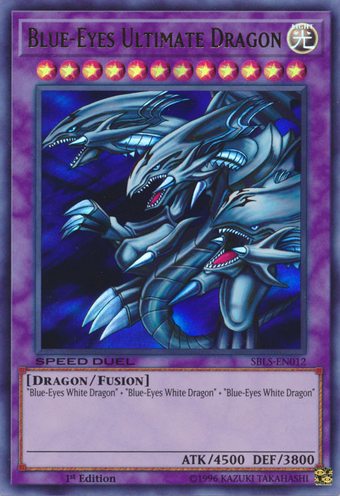
Fusion Summon
Being the OG Special Summoning mechanic, Fusions along with Rituals have existed the longest. However, unlike Rituals, Fusions have been supported quite a lot. It is still a very viable summoning mechanic. Therefore, it is no surprise that they have evolved quite a lot to keep up with the new summoning mechanics.
To Fusion Summon, the player must use a Fusion Spell (Polymerization) to fuse two monsters to summon a monster from the Extra Deck.
Buffed Up Attack (1999)
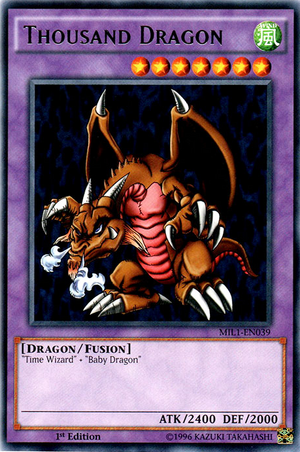 In 1999, Konami debuted Thousand Dragon. A generic Fusion monster that is also the signature card of Joey Wheeler from the anime. It's the first Fusion Monster to sport a high attack compared to its Fusion Materials. Prior Fusions are only slightly stronger than its Fusion Materials (e.g. Around 200-500 ATK points higher) or it has a problematic summoning condition (e.g. Blue-Eyes Ultimate Dragon). After the release of Thousand Dragon, Konami would go on to release Fusion Monsters with significantly higher ATK than its materials, such as Labyrinth Tank and Twin-Headed Thunder Dragon. Eventually, they'll release two of the strongest ATK Fusions in the game known as Five-Headed Dragon and Dragon Master Knight. They both sport 5000 ATK points.
In 1999, Konami debuted Thousand Dragon. A generic Fusion monster that is also the signature card of Joey Wheeler from the anime. It's the first Fusion Monster to sport a high attack compared to its Fusion Materials. Prior Fusions are only slightly stronger than its Fusion Materials (e.g. Around 200-500 ATK points higher) or it has a problematic summoning condition (e.g. Blue-Eyes Ultimate Dragon). After the release of Thousand Dragon, Konami would go on to release Fusion Monsters with significantly higher ATK than its materials, such as Labyrinth Tank and Twin-Headed Thunder Dragon. Eventually, they'll release two of the strongest ATK Fusions in the game known as Five-Headed Dragon and Dragon Master Knight. They both sport 5000 ATK points.
Konami has continued this high Attack trend to the point where modern Fusion Monsters often have Attack ranging from 2500-3000.
Searching Materials (1999)
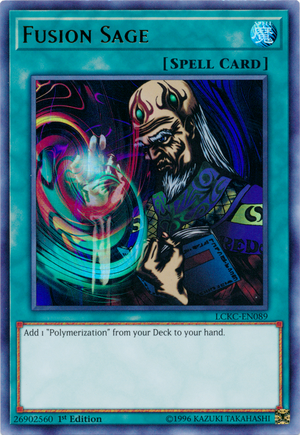 In 1999, Konami debuted Fusion Sage. The first card that allows the player to search out Polymerization. This spell alone sets the trend for Fusion Spell searching in modern Fusion Archetypes. Konami further evolved this mechanic with the release of Thunder Dragon in 2000. The first monster with an effect that allows the player to search out the materials needed for a Fusion Summon. Konami has since released many Fusion Archetypes with cards that often search out the Fusion Materials (e.g. Fluffal Owl and Fluffal Dog search Polymerization and any Fusion Materials).
In 1999, Konami debuted Fusion Sage. The first card that allows the player to search out Polymerization. This spell alone sets the trend for Fusion Spell searching in modern Fusion Archetypes. Konami further evolved this mechanic with the release of Thunder Dragon in 2000. The first monster with an effect that allows the player to search out the materials needed for a Fusion Summon. Konami has since released many Fusion Archetypes with cards that often search out the Fusion Materials (e.g. Fluffal Owl and Fluffal Dog search Polymerization and any Fusion Materials).
Fusion Substitute (1999)
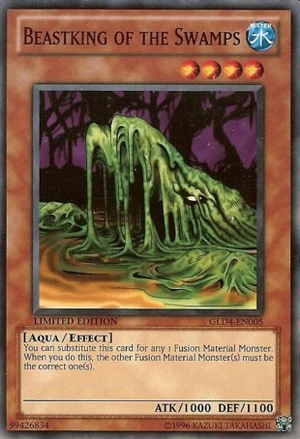 Konami released Beastking of the Swamps in 1999. Beastking of the Swamps enables the player to substitute Beastking for one of the Fusion Materials. It even saw a beefed-up version in 2004 known as King of the Swamp, which has the same effect but with an additional effect of searching out Polymerization.
Konami released Beastking of the Swamps in 1999. Beastking of the Swamps enables the player to substitute Beastking for one of the Fusion Materials. It even saw a beefed-up version in 2004 known as King of the Swamp, which has the same effect but with an additional effect of searching out Polymerization.
Konami would later continue this trend of substituting fusion materials with the release of cards, such as Goddess with the Third Eye, Mystical Sheep #1, Hex-Sealed Fusion, Versago the Destroyer, Shaddoll Core, Fusion Parasite, Patchwork Fluffal and Muddy Dragon.
Konami would later print some Fusions with a clause: "Must first be Fusion Summoned with the above Fusion Materials," which disables players from using these Fusion Substitutes to Fusion Summon a monster.
Skipping Fusion (1999)
Cyber-Stein debuted in 1999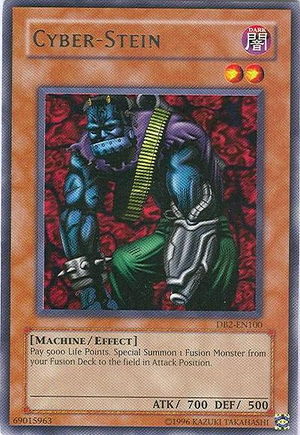 . It is an Effect Monster that Special Summons a Fusion Monster from the Extra Deck without actually fusing any monsters. Despite it summoning a Fusion, the summoning itself isn't counted as a Fusion Summon. Therefore, if the Fusion went to the graveyard, it cannot be revived.
. It is an Effect Monster that Special Summons a Fusion Monster from the Extra Deck without actually fusing any monsters. Despite it summoning a Fusion, the summoning itself isn't counted as a Fusion Summon. Therefore, if the Fusion went to the graveyard, it cannot be revived.
Konami would evolve the gimmick of skipping the fusing process with cards like Metamorphosis, Magical Scientist, Summoner of Illusions, Metaltron XII and Cybernetic Revolution. The two Fusions, Super Roboyarou and Super Robolady both have effects that Special Summon each other out without actually performing a Fusion Summon.
They would further evolve this gimmick by including the clause "This is treated as a Fusion Summon" in cards, such as Instant Fusion. This is done so players can revive the Fusions if they somehow end up in the grave.
Effects (2000)
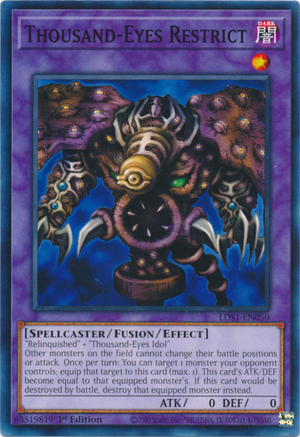 In 2000, Thousand-Eyes Restricted debuted. It was the first Effect Fusion Monster. It was so powerful that it was a keycard in "Goat Format." Konami would then release its second Effect Fusion Monster, The Last Warrior from Another Planet, in 2001. The next three Fusion Monsters that came in the core pack, Ryu Senshi, Dark Balter the Terrible and Fiend Skull Dragon, all have effects. Since then, Fusions often comes with effects with Sea Monster of Theseus being the only modern generic Fusion Monster.
In 2000, Thousand-Eyes Restricted debuted. It was the first Effect Fusion Monster. It was so powerful that it was a keycard in "Goat Format." Konami would then release its second Effect Fusion Monster, The Last Warrior from Another Planet, in 2001. The next three Fusion Monsters that came in the core pack, Ryu Senshi, Dark Balter the Terrible and Fiend Skull Dragon, all have effects. Since then, Fusions often comes with effects with Sea Monster of Theseus being the only modern generic Fusion Monster.
Alternate Fusion Spell (2001)
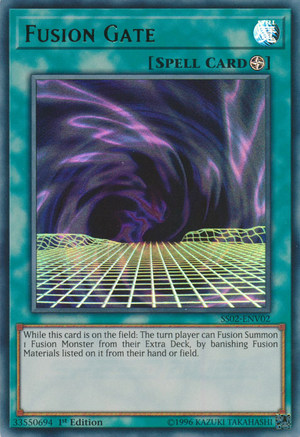 Fusion Gate debuted in 2001. It is a Field Spell that enables the player to banish materials to perform a Fusion Summon. Being a Field Spell enables the player to search it out with Terraforming (Note: Terraforming isn't released till 2002) with the bonus of enabling the player to not worry about running out of Fusion Spells. However, the drawback is that the fusion materials are banished instead of being sent to the grave. Fusion Gate would slowly start the trend of alternate Fusion Spell Card. For the longest time, Fusion Summoning was only done via Polymerization. Fusion Gate would later inspire modern Fusion Spells, such as Gemknight Fusion and Power Bond.
Fusion Gate debuted in 2001. It is a Field Spell that enables the player to banish materials to perform a Fusion Summon. Being a Field Spell enables the player to search it out with Terraforming (Note: Terraforming isn't released till 2002) with the bonus of enabling the player to not worry about running out of Fusion Spells. However, the drawback is that the fusion materials are banished instead of being sent to the grave. Fusion Gate would slowly start the trend of alternate Fusion Spell Card. For the longest time, Fusion Summoning was only done via Polymerization. Fusion Gate would later inspire modern Fusion Spells, such as Gemknight Fusion and Power Bond.
Specific Fusion Materials (2001)
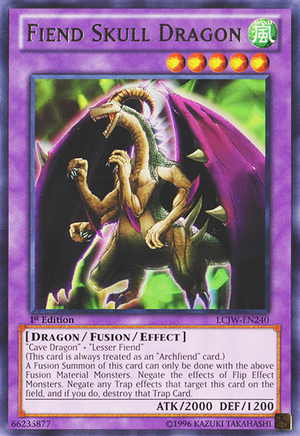 In 2001, Konami released these two Fusions, Fiend Skull Dragon and Dark Balter the Terrible. These two Fusions have this clause, "A Fusion Summon of this card can only be done with the above Fusion Material Monsters". This clause makes it so a Fusion Summon can only be performed using specific Fusion Materials. Therefore, you can't use Fusion Substitutes (Beastking of the Swamp) to replace one of its material.
In 2001, Konami released these two Fusions, Fiend Skull Dragon and Dark Balter the Terrible. These two Fusions have this clause, "A Fusion Summon of this card can only be done with the above Fusion Material Monsters". This clause makes it so a Fusion Summon can only be performed using specific Fusion Materials. Therefore, you can't use Fusion Substitutes (Beastking of the Swamp) to replace one of its material.
This clause is often used to restrict specific Fusions to stop players from cheesing out powerful fusions too quickly. Some famous modern Fusions with this clause include Lunalight Leo Panther Dancer, Invoked Elysium and Imperion Magnum the Superconductive Battlebot.
Multiple Paths Fusion (2001)
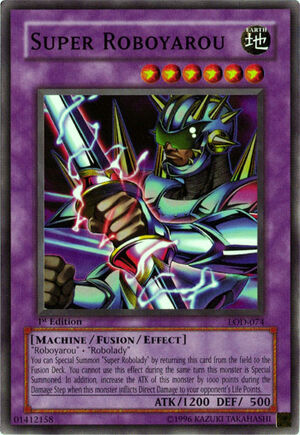 In 2001, Konami introduced the first multiple paths fusions with the debut of both Super Robolady and Super Roboyarou. These are fusions that use the same fusion materials, but the players have the options to choose which monster they want to Fusion Summon. This inspires the design of many future fusions. Remember how if you fuse both Elemental Hero Avian and Elemental HERO Burstinatrix, you can either Fusion Summon Flame Wingman or Phoenix Enforcer? Both Super Robolady and Super Roboyarou inspired that. Do you know how you can either Fusion Summon Frightfur Dog or Frightfur Tiger despite using the same fusion materials? Both Super Robolady and Super Robyarou also inspired that.
In 2001, Konami introduced the first multiple paths fusions with the debut of both Super Robolady and Super Roboyarou. These are fusions that use the same fusion materials, but the players have the options to choose which monster they want to Fusion Summon. This inspires the design of many future fusions. Remember how if you fuse both Elemental Hero Avian and Elemental HERO Burstinatrix, you can either Fusion Summon Flame Wingman or Phoenix Enforcer? Both Super Robolady and Super Roboyarou inspired that. Do you know how you can either Fusion Summon Frightfur Dog or Frightfur Tiger despite using the same fusion materials? Both Super Robolady and Super Robyarou also inspired that.
Konami would later put a twist in this concept with Evil HERO. Where players have access to different fusion monsters based on the Fusion Spell card they use (e.g. Burstinatrix and Avian = Flamed Wingman, but if you use Dark Fusion, you'll get Evil HERO Inferno Wing instead).
Contact Fusion (2002)
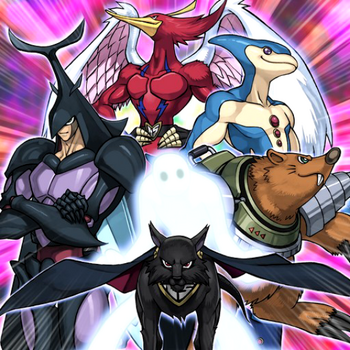 Whenever people think of Contact Fusion, many points to Neo-Spacians for introducing it. However, Konami introduced Contact Fusion back in 2002 with XYZ Dragons Series (XY-Dragon Cannon, XYZ-Dragon Cannon, XZ-Tank Cannon and YZ-Tank Dragon). However, unlike modern Contact Fusion, players must banish the materials from the Field. Contact Fusion is when a player performs a Fusion by fusing two monsters on the Field together without using a Fusion Spell. The Fusion process itself isn't an effect from the Fusion Materials, but a summoning condition from the Fusion Monsters themselves. Due to how similar Contact Fusion is to Synchro Summoning, many people often see Contact Fusion as a prototype for Synchros.
Whenever people think of Contact Fusion, many points to Neo-Spacians for introducing it. However, Konami introduced Contact Fusion back in 2002 with XYZ Dragons Series (XY-Dragon Cannon, XYZ-Dragon Cannon, XZ-Tank Cannon and YZ-Tank Dragon). However, unlike modern Contact Fusion, players must banish the materials from the Field. Contact Fusion is when a player performs a Fusion by fusing two monsters on the Field together without using a Fusion Spell. The Fusion process itself isn't an effect from the Fusion Materials, but a summoning condition from the Fusion Monsters themselves. Due to how similar Contact Fusion is to Synchro Summoning, many people often see Contact Fusion as a prototype for Synchros.
Konami would later apply this same gimmick in many archetypes/cards, e.g. Neo-Spacians, Gladiator Beasts, Sacred Beasts Fusions, Chimeratech Fortress Dragon, Ritual Beasts, Thunder Dragon, Trishula, The Dragon of Icy Prison, etc.)
Konami has evolved this concept with the release of the Thunder Dragon Titan and Thunder Dragon Colossus. It doesn't require specific materials. You only need to Tribute one monster to Fusion Summon Thunder Dragon Colossus. For Thunder Dragon Titan, players don't need to have both materials on the Field.
Floating Effects (2002)
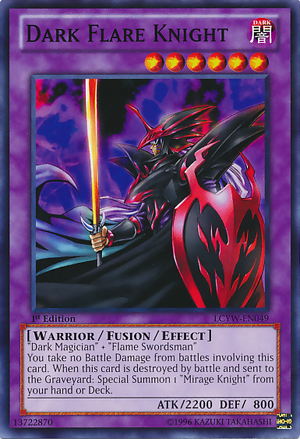 To keep up with modern mechanics, new Fusions have effects that float or recover materials if they leave the field. For example, all the Shaddoll Fusions have effects that enable players to recover a card back from the Grave. This trend started in 2002 when Konami debuted Dark Flare Knight. Upon destruction, it will Special Summon a Mirage Knight. Despite this floating ability, Mirage Knight is a Nomi monster which doesn't help the players with future fusion summons.
To keep up with modern mechanics, new Fusions have effects that float or recover materials if they leave the field. For example, all the Shaddoll Fusions have effects that enable players to recover a card back from the Grave. This trend started in 2002 when Konami debuted Dark Flare Knight. Upon destruction, it will Special Summon a Mirage Knight. Despite this floating ability, Mirage Knight is a Nomi monster which doesn't help the players with future fusion summons.
Konami would evolve this mechanic by having Fusion Floaters either retrieve/recover Fusion Spells or Fusion Materials as shown with Shaddolls, Predaplant Chimerafflesia and Mokey Mokey King.
Transformation Summon (2002)
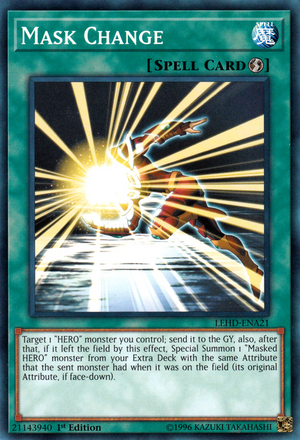 We all know the famous archetype, Masked HERO, or more specifically, Masked HERO Dark Law. The archetype is well known for a Fusion that actively punished grave-reliant combo decks. What's worst is the spell card, Mask Change, which allows players to send one monster to the grave to Special Summon a Fusion with the same attribute. This is known as Transformation Summon in the GX manga. Despite the archetype being well-known for this mechanic, this mechanic has existed long before Masked Hero. Did you know that Neo-Spacian attempted this mechanic with their spell card, NEX, a couple of years earlier? Did you also know that this mechanic first debuted back in 2002 with the spell card, Metamorphosis? What all three have in common is that the summon itself isn't counted as a Fusion Summon.
We all know the famous archetype, Masked HERO, or more specifically, Masked HERO Dark Law. The archetype is well known for a Fusion that actively punished grave-reliant combo decks. What's worst is the spell card, Mask Change, which allows players to send one monster to the grave to Special Summon a Fusion with the same attribute. This is known as Transformation Summon in the GX manga. Despite the archetype being well-known for this mechanic, this mechanic has existed long before Masked Hero. Did you know that Neo-Spacian attempted this mechanic with their spell card, NEX, a couple of years earlier? Did you also know that this mechanic first debuted back in 2002 with the spell card, Metamorphosis? What all three have in common is that the summon itself isn't counted as a Fusion Summon.
Konami would later evolve this mechanic with The Eye of Timaeus, The Fang of Critias and The Claw of Hermos. All three share the same mechanic as Mask Change, except that the summon is treated as a Fusion Summon.
Fusion Archetypes (2005)
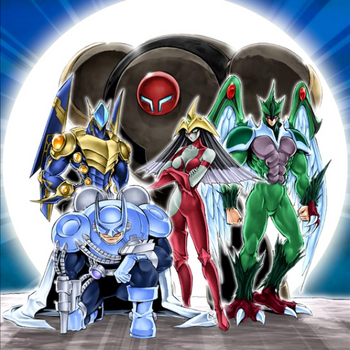 In 2005, Konami introduced Elemental HERO - Flame Wingman and Elemental HERO - Thunder Giant. They are the first two fusions belonging to an archetype that is known for Fusion Summoning. Being the first Fusion Archetype, they eventually inspire the design of many future Fusion Archetypes that came after it. Furthermore, they're also responsible for setting many trends for modern fusions.
In 2005, Konami introduced Elemental HERO - Flame Wingman and Elemental HERO - Thunder Giant. They are the first two fusions belonging to an archetype that is known for Fusion Summoning. Being the first Fusion Archetype, they eventually inspire the design of many future Fusion Archetypes that came after it. Furthermore, they're also responsible for setting many trends for modern fusions.
Konami has since released many Fusion Archetypes including Ancient Gear, Melodious, Lunalight, Frightfur, Roids, Gladiator Beasts, Gem-Knight, Ritual Beasts, Shaddoll and Fossil Fusions.
Flexible Fusion Materials (2005)
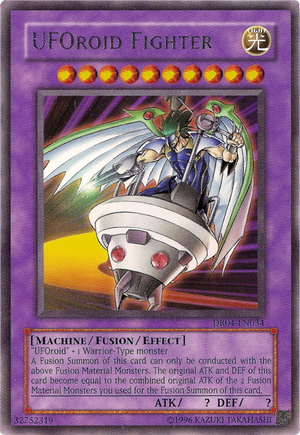 In 2005, Konami debuted UFOroid Fighter. It's the first time Konami released a Fusion with flexible Fusion material. Rather than having two or three specific monsters, UFOroid Fighter only needs the player to have one specific monster and the other can be any Warrior-Type monsters.
In 2005, Konami debuted UFOroid Fighter. It's the first time Konami released a Fusion with flexible Fusion material. Rather than having two or three specific monsters, UFOroid Fighter only needs the player to have one specific monster and the other can be any Warrior-Type monsters.
Fast forward to current day, Fusion Monsters nowadays often follow this same summoning principle with one specific Fusion Material (e.g. Frightfur Tiger and Frightfur Wolf) or have two non-specific Fusion Materials (e.g. Plunder Patrollship LYS and Shaddoll Fusions).
Fusion Recovery (2005)
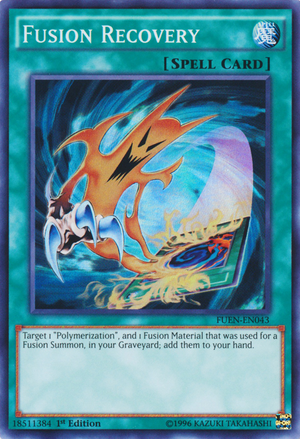 Before 2005, Fusions were a one-off mechanic that players summon maybe once or twice in a duel. In 2005, with the focus on Fusions, Konami started pushing Fusion as a viable method. The problem is many Fusion Archetype can only Summon their Fusions three times at most due to there being only three Polymerization (if you're not using Fusion Gate). Furthermore, it also causes the player to lose way too much hand advantage. Konami countered this by releasing Fusion Recovery. It's a card that lets the player recover one Polymerization and Fusion Material in the Graveyard.
Before 2005, Fusions were a one-off mechanic that players summon maybe once or twice in a duel. In 2005, with the focus on Fusions, Konami started pushing Fusion as a viable method. The problem is many Fusion Archetype can only Summon their Fusions three times at most due to there being only three Polymerization (if you're not using Fusion Gate). Furthermore, it also causes the player to lose way too much hand advantage. Konami countered this by releasing Fusion Recovery. It's a card that lets the player recover one Polymerization and Fusion Material in the Graveyard.
Since then, as mentioned in "Floating Effects", Konami has partially embedded the effects from Fusion Recovery to many Fusion Monsters or Fusion Material Monsters to allow the player to recover resources to perform further fusions.
Fusing From Grave (2005)
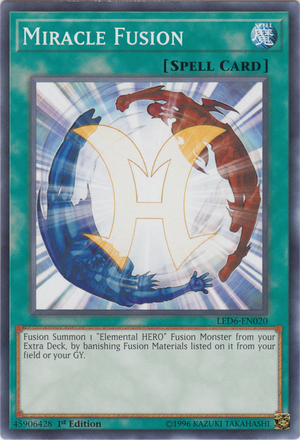 Konami debuted Miracle Fusion in 2005 for the HEROES archetype. Miracle Fusion is a spell card that enables players to perform a fusion summon by banishing material from the Graveyard.
Konami debuted Miracle Fusion in 2005 for the HEROES archetype. Miracle Fusion is a spell card that enables players to perform a fusion summon by banishing material from the Graveyard.
Konami later further evolved this gimmick by creating cards like Overload Fusion, Dark Calling, Dragon's Mirror, Magicalized Fusion, Necro Fusion and Miracle Synchro Fusion.
Sending materials from the Deck (2006)
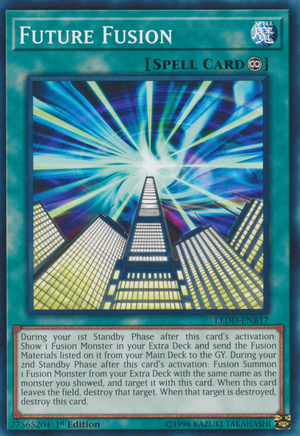 Konami debuted Future Fusion in 2006. A very powerful continuous spell that sends the fusion materials from the Deck to the graveyard to perform a fusion summons two turns later. This card nets you a Fusion with no minus to also setting up the grave with further combos. It was so powerful that Konami issued an errata to nerf the card.
Konami debuted Future Fusion in 2006. A very powerful continuous spell that sends the fusion materials from the Deck to the graveyard to perform a fusion summons two turns later. This card nets you a Fusion with no minus to also setting up the grave with further combos. It was so powerful that Konami issued an errata to nerf the card.
Konami used this gimmick again on many of the modern Archetype's fusion spells. For example, Brilliant Fusion, Red-Eyes Fusion and Shaddol Fusion.
Copying Name (2007)
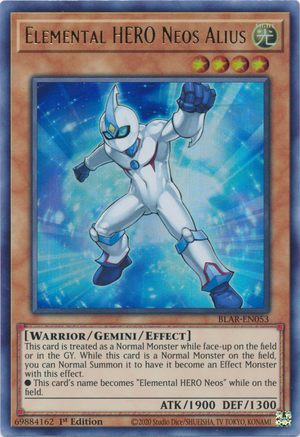 In 2007, Konami released Elemental HERO Neos Alius. It's a Gemini monster that has its name become Elemental HERO Neos once it's Normal Summoned again. As mentioned before in "Fusion Substitute", later Fusions have a clause that prevents the player from using Fusion Substitute to perform a Fusion Summon. However, monsters that copy another name bypasses that clause. Therefore, allowing players to substitute specific Fusion materials with monsters that mimics the name of fusion material. Neos Alius isn't the first monster to copy a name of another monster, but it's the first monster to do so for the sole purpose to perform a Fusion Summon. However, being a Gemini monster, it was slow and restrictive. Konami would later evolve this mechanic by inventing more manageable copying effects in the form of Elemental HERO Prisma, Crystal Rose and Fusion Tag.
In 2007, Konami released Elemental HERO Neos Alius. It's a Gemini monster that has its name become Elemental HERO Neos once it's Normal Summoned again. As mentioned before in "Fusion Substitute", later Fusions have a clause that prevents the player from using Fusion Substitute to perform a Fusion Summon. However, monsters that copy another name bypasses that clause. Therefore, allowing players to substitute specific Fusion materials with monsters that mimics the name of fusion material. Neos Alius isn't the first monster to copy a name of another monster, but it's the first monster to do so for the sole purpose to perform a Fusion Summon. However, being a Gemini monster, it was slow and restrictive. Konami would later evolve this mechanic by inventing more manageable copying effects in the form of Elemental HERO Prisma, Crystal Rose and Fusion Tag.
Super Polymerization (2007)
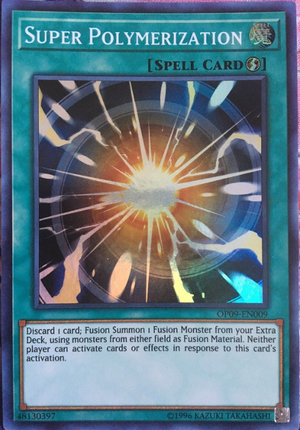 Konami released Super Polymerization in 2007. A powerful Quick-Play Spell that summons a Fusion by fusing monsters from your hand or anywhere on the field (including your opponent's field). This effect was so powerful that Konami banned Super Polymerization for many years.
Konami released Super Polymerization in 2007. A powerful Quick-Play Spell that summons a Fusion by fusing monsters from your hand or anywhere on the field (including your opponent's field). This effect was so powerful that Konami banned Super Polymerization for many years.
Since then, Konami has evolved this mechanic with cards like A.I. Love Fusion, Predaprime Fusion and Fusion of Fire.
Limiting the Number (2008)
Konami introduced Master Rule 1 in 2008 with the release of Synchros. One of the most significant changes in this rule is that players can now only keep up to 15 cards in their Extra Deck (formerly known as Fusion Deck). Before this change, Konami often released many Fusions for Fusion Archetypes (e.g. HEROES). With the unlimited space, players can access all the Fusions released for an archetype. However, with the new Master Rule, players found themselves only allowed to pick at most 15. Therefore, pumping out fusions for Fusion Archetype is no longer feasible. That's why we have never seen another giant Fusion Archetype like HEROES.
To compensate this, Konami decided to go with the philosophy "Quality over Quantity". Instead of releasing many fusions with niche and specific effects, Konami decided to release two to three Fusions for archetypes with exceptional effects.
Number Reliant (2009)
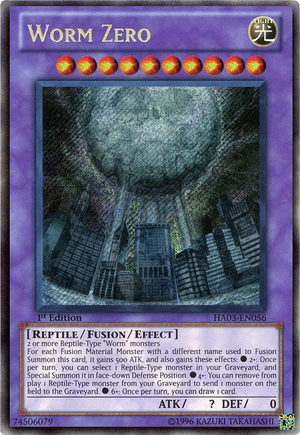 In 2009, Konami debuted Worm Zero. It's the first Fusion monster that gains effect based on the number of materials used for its Fusion Summon. Konami would later revisit this gimmick again with Infernoid Tierra, Frightfur Tiger, Frightfur Wolf and Frightfur Saber-Tooth. However, unlike Worm Zero, both Frightfur Tiger and Wolf gain additional targets/attacks rather than gaining brand new effects.
In 2009, Konami debuted Worm Zero. It's the first Fusion monster that gains effect based on the number of materials used for its Fusion Summon. Konami would later revisit this gimmick again with Infernoid Tierra, Frightfur Tiger, Frightfur Wolf and Frightfur Saber-Tooth. However, unlike Worm Zero, both Frightfur Tiger and Wolf gain additional targets/attacks rather than gaining brand new effects.
Trap Fusion (2010)
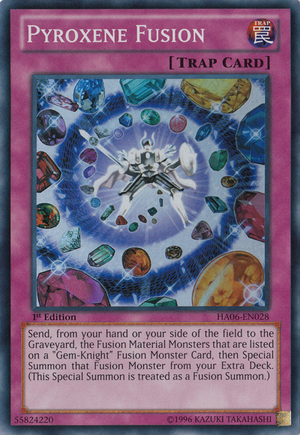 Konami released a trap card, Pyroxene Fusion, for Gem-knight in 2010. It is a trap card that enables the player to perform a Fusion Summon by sending the materials to the graveyard. Being a trap card, this allows the player to perform a Fusion Summon on the opponent's turn. However, this is mostly useless for Gem-knight as most of their Fusion Monsters are player's turn reliant.
Konami released a trap card, Pyroxene Fusion, for Gem-knight in 2010. It is a trap card that enables the player to perform a Fusion Summon by sending the materials to the graveyard. Being a trap card, this allows the player to perform a Fusion Summon on the opponent's turn. However, this is mostly useless for Gem-knight as most of their Fusion Monsters are player's turn reliant.
Overtime, Konami has further evolved this gimmick of Trap Fusion. Since then, many trap fusion cards usually either skip the whole paying materials (Frightfur March) or enables the player to banish the materials from the Grave (Necro Fusion).
These are some examples of Trap Fusion Cards currently in the game: Fragment Fusion, Frightfur March, Unification of the Cubic Lord, D-Fusion, Predaplanet and Necrofusion.
Teaming with Synchro (2010)
I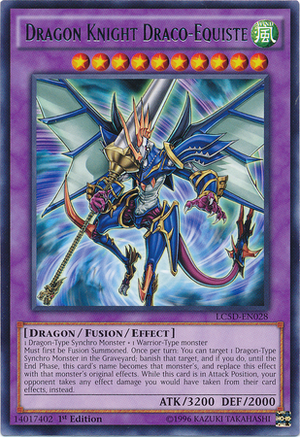 n 2010, Synchro replaced Fusion as the go-to Special Summoning mechanic. It was also the time where the anniversary cross over movie came out. As one of the main characters in that movie is a Fusion user, Konami decided to promote it by re-releasing Fusions. The cards that came out during this period often pair Fusion with Synchros.
n 2010, Synchro replaced Fusion as the go-to Special Summoning mechanic. It was also the time where the anniversary cross over movie came out. As one of the main characters in that movie is a Fusion user, Konami decided to promote it by re-releasing Fusions. The cards that came out during this period often pair Fusion with Synchros.
For example, Synchro Fusionist is a monster that searches out Fusion Spells. Many fusions in this period (e.g. Dragon Knight Draco-Equiste and Ultimate Axon Kicker) requires a synchro monster as its fusion material. The spell card, Miracle Synchro Fusion, is a convoluted Miracle Fusion that only works if the fusion material is a synchro monster.
Changing Attribute then Fusion (2014)
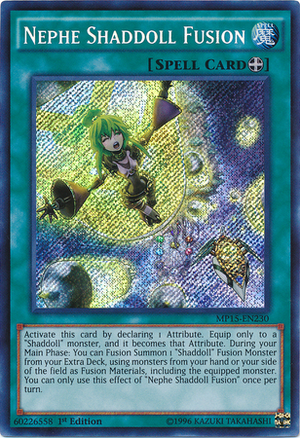 In 2014, Konami debuted Nephe Shaddoll Fusion. It's an Equip Card that changes the Attribute of the monster and then performs a Fusion Summon. This is the first time an Equip Card is used to perform a Fusion Summon, and it's also the first and only time where a spell card changes the attribute of a monster and then perform a Fusion Summon.
In 2014, Konami debuted Nephe Shaddoll Fusion. It's an Equip Card that changes the Attribute of the monster and then performs a Fusion Summon. This is the first time an Equip Card is used to perform a Fusion Summon, and it's also the first and only time where a spell card changes the attribute of a monster and then perform a Fusion Summon.
Konami has yet to replicate this gimmick, but this could be due to many modern Fusions not being reliant on attributes to perform a Fusion Summon.
Monster Effect Fusion (2014)
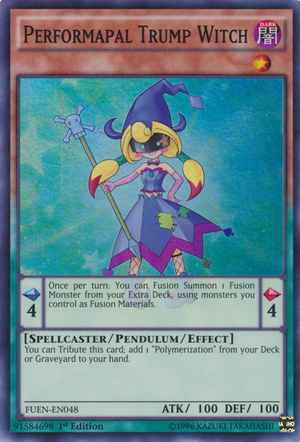 Performapal Trump Witch debuted to the OCG in 2014. It is a pendulum monster that has a pendulum effect that allows the player to perform a Fusion Summon. This isn't the first time a monster has the ability to summon a Fusion Monster from the Extra Deck (Cyber Stein). However, Trump Witch is the first card to Summon a Fusion and treats the process as a Fusion Summon.
Performapal Trump Witch debuted to the OCG in 2014. It is a pendulum monster that has a pendulum effect that allows the player to perform a Fusion Summon. This isn't the first time a monster has the ability to summon a Fusion Monster from the Extra Deck (Cyber Stein). However, Trump Witch is the first card to Summon a Fusion and treats the process as a Fusion Summon.
Since then, monster effect fusion is quite common in Fusion Archetypes. Melodious has Soprano of the Melodious Songstress. D/D has D/D Necro Slime and D/D Swirl Slime. Curse of Dragon has Curse of Dragonfire. Lunalight has Lunalight Wolf. Predaplant has Predaplant Chlamydosundew.
Grind Fusion (2015)
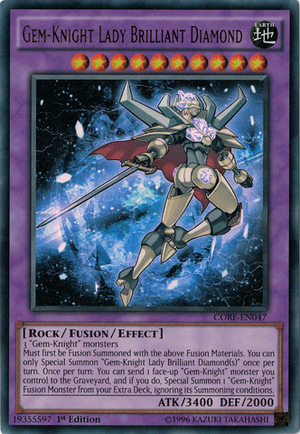 Konami released Gem-Knight Lady Brilliant Diamond in 2015. It is a Fusion that Fusion Summons another Gem-Knight Fusion by sending one Gem-Knight monster to the grave. This process is called "Grind Fusion" in the anime. Similar to Transformative Summon (Masked Change), the difference is that the player doesn't waste a spell card doing this.
Konami released Gem-Knight Lady Brilliant Diamond in 2015. It is a Fusion that Fusion Summons another Gem-Knight Fusion by sending one Gem-Knight monster to the grave. This process is called "Grind Fusion" in the anime. Similar to Transformative Summon (Masked Change), the difference is that the player doesn't waste a spell card doing this.
Konami has yet to revisit this concept. Many modern Fusions have effects that summons a Fusion by fusing materials, but never by just sending one material to the graveyard through an effect.
Fusing from the Extra Deck (2015)
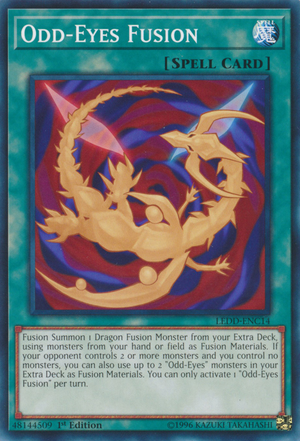 2015 saw the release of Odd-Eyes Fusion. It is the first and only spell card to fuse monsters directly from the Extra Deck if the opponent controls more than two monsters while you control no monsters. This is great for Pendulums as Pendulum monsters go to the Extra Deck when they leave the field.
2015 saw the release of Odd-Eyes Fusion. It is the first and only spell card to fuse monsters directly from the Extra Deck if the opponent controls more than two monsters while you control no monsters. This is great for Pendulums as Pendulum monsters go to the Extra Deck when they leave the field.
Interestingly, a card with similar effect actually predates Odd-Eyes Fusion. The manga only card, Extra Fusion, predate Odd-Eyes Fusion back in 2010.
Fusing Traps and Spells (2015)
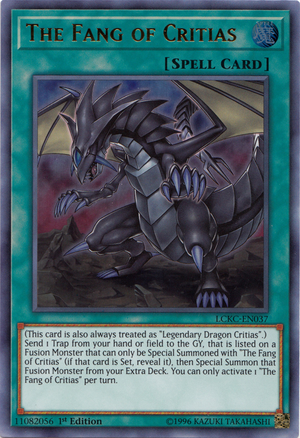 In 2015, Konami finally debuted the rest of the Legendary Dragon archetype, The Fang of Critias and The Claw of Hermos. Both these two spell cards do something extremely unique. The Fang of Critias performs a fusion using Trap Cards, while the Claw of Hermos performs a Fusion using Spell Cards.
In 2015, Konami finally debuted the rest of the Legendary Dragon archetype, The Fang of Critias and The Claw of Hermos. Both these two spell cards do something extremely unique. The Fang of Critias performs a fusion using Trap Cards, while the Claw of Hermos performs a Fusion using Spell Cards.
Since then, Konami has evolved this mechanic a bit. The Vision HERO archetype has Vision Fusion which allows the player to fuse Vision HERO monsters in the Spell/Trap Zone (technically, they're treated as a Continuous Spell Card). Pendulum Fusion is also another spell card that enables the player to fuse Pendulum Monsters in the Pendulum Zones (Again, technically a spell card).
Fusion Climb (2016)
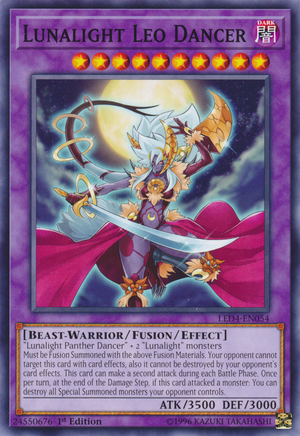 As Archetypes began to adopt the philosophy of focusing on one strength rather than being the "Jack of all trades, master of none," designing Fusion for Fusion archetypes became difficult. This difficulty is very present for the Frightfur Archetype where players can access burn damage (Frightfur Leo), Trap/Spell Deactivation (Frightfur Sheep), High beatstick (Frightfur Daredevil) and stealing monsters (Frightfur Chimera), but no one really uses those Fusions. Instead, players use Fusions based on what the archetype does best, which is to score a quick OTK with Frightfur Tiger, Wolf, Kraken and Saber-Tooth. Furthermore, Tiger, Wolf, Kraken and Saber-Tooth do a better job than what Sheep, Leo, Chimera and Daredevil can do. This resulted in many players not even using half the Fusions released for a certain archetype. Therefore, how does Konami address this issue? They did so by introducing the concept of Fusion Climbing.
As Archetypes began to adopt the philosophy of focusing on one strength rather than being the "Jack of all trades, master of none," designing Fusion for Fusion archetypes became difficult. This difficulty is very present for the Frightfur Archetype where players can access burn damage (Frightfur Leo), Trap/Spell Deactivation (Frightfur Sheep), High beatstick (Frightfur Daredevil) and stealing monsters (Frightfur Chimera), but no one really uses those Fusions. Instead, players use Fusions based on what the archetype does best, which is to score a quick OTK with Frightfur Tiger, Wolf, Kraken and Saber-Tooth. Furthermore, Tiger, Wolf, Kraken and Saber-Tooth do a better job than what Sheep, Leo, Chimera and Daredevil can do. This resulted in many players not even using half the Fusions released for a certain archetype. Therefore, how does Konami address this issue? They did so by introducing the concept of Fusion Climbing.
In 2016, Konami released Lunalight Cat Dancer, Lunarlight Panther Dancer and Lunalight Leo Dancer. All three Fusions have a similar effect, but slightly more powerful. To get to Leo Dancer, the player must perform a Fusion using Panther Dancer as a material. Similarly, to Summon Leo Dancer, the player must use Cat Dancer as a Fusion Material. This forces player to use all the Fusions from the archetype rather than just abandoning Cat Dancer and Panther Dancer because Leo Dancer is stronger. It should be noted that Lunalight isn't the first archetype to use a Fusion Monster from their archetype as a material, but it's the first to have this Fusion Climbing gameplay.
Konami reused this gimmick for Predaplants (Chimerafflesia -> Dragostapelia), Starving Venom (Starving Venom Fusion Dragon -> Greedy Venom Fusion Dragon) and Destiny HERO (Destiny HERO - Dystopia -> Destiny HERO - Dusktopia).
Fusing from either Grave (2016)
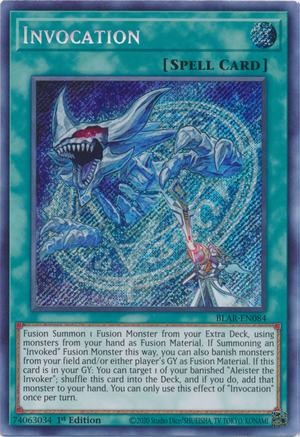 Konami introduced the Invocation Archetype to the world in 2016. It's an archetype with a unique gimmick of fusing monsters from either player's graveyard.
Konami introduced the Invocation Archetype to the world in 2016. It's an archetype with a unique gimmick of fusing monsters from either player's graveyard.
Interestingly, this concept of fusing from both player's grave actually first debuted in the anime back in 2006 with Fossil Fusion. What make this even more interesting is that Konami later released Fossil Fusion in 2020.
Fusion Tuner (2017)
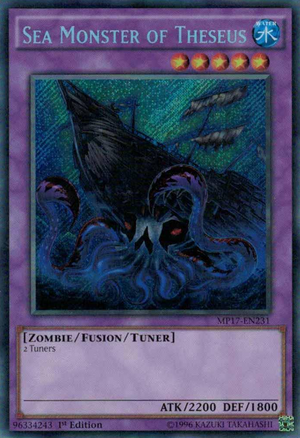 In 2017, TCG teased the strongest card TCG Exclusive in the Raging Tempest Booster Pack. Many people were hyped only to be let down as they unveiled Sea Monster of Theseus. Sea Monster of Theseus is a vanilla Fusion monster. However, it does has its pros. It's a Fusion Tuner monster, which enables the player to perform Synchro Summon (or Summon Ultimaya Tzolkin). Being a Level 5 means players can easily cheese it out with Instant Fusion.
In 2017, TCG teased the strongest card TCG Exclusive in the Raging Tempest Booster Pack. Many people were hyped only to be let down as they unveiled Sea Monster of Theseus. Sea Monster of Theseus is a vanilla Fusion monster. However, it does has its pros. It's a Fusion Tuner monster, which enables the player to perform Synchro Summon (or Summon Ultimaya Tzolkin). Being a Level 5 means players can easily cheese it out with Instant Fusion.
So far, Sea Monster of Theseus is the only Fusion Tuner in the game.
Pendulum Fusion (2017)
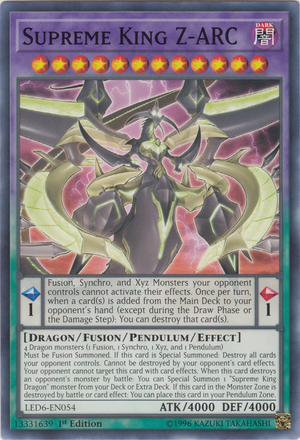 In 2017, Konami released the first Pendulum Fusion, Supreme King Z-ARC. Being a hybrid Pendulum and Fusion monster grants this monster the ability to become a pendulum scale once it's destroyed.
In 2017, Konami released the first Pendulum Fusion, Supreme King Z-ARC. Being a hybrid Pendulum and Fusion monster grants this monster the ability to become a pendulum scale once it's destroyed.
Konami would later release three more Pendulum Fusion monsters, D/D/D Super Doom King Purple Armageddon, Starving Venemy Lethal Dose Dragon and Odd-Eyes Venom Dragon.
Multi Use Spell Card (2019)
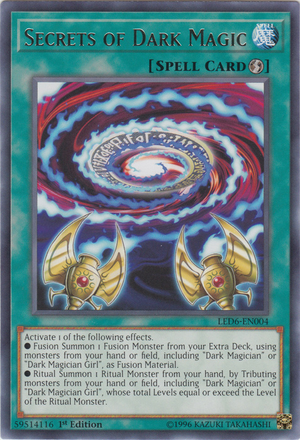 Konami released a support card for the Dark Magician archetype in 2019 known as Secrets of Dark Magic. Unlike all previous spell card that enables Fusion Summon, this card also allows players to perform a Ritual Summon.
Konami released a support card for the Dark Magician archetype in 2019 known as Secrets of Dark Magic. Unlike all previous spell card that enables Fusion Summon, this card also allows players to perform a Ritual Summon.
As of now, we have yet to see a spell card that performs both a Fusion or Ritual Summon.
Destroying Fusion Materials (2019)
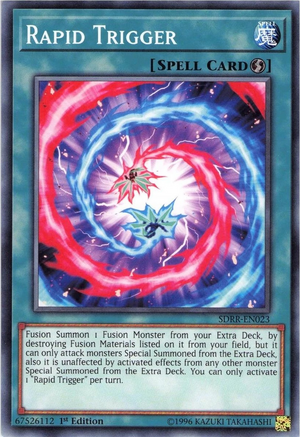 In 2019, Konami released the Fusion Spell, Rapid Trigger. It's a spell card that performs a Fusion Summon by destroying the Fusion Materials. This is beneficial for monsters that trigger upon destruction (e.g. Rokket). As this card is still relatively new, we have yet to see Konami further improve this gimmick.
In 2019, Konami released the Fusion Spell, Rapid Trigger. It's a spell card that performs a Fusion Summon by destroying the Fusion Materials. This is beneficial for monsters that trigger upon destruction (e.g. Rokket). As this card is still relatively new, we have yet to see Konami further improve this gimmick.
Harmonic Synchro Fusion (2016) (ANIME ONLY)
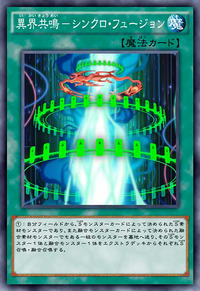 In the Arc-V Anime, the character Sergey played a spell card known as Harmonic Synchro Fusion in an episode debuted back in 2016. The spell card simultaneously Fusion Summon and Synchro Summon both a Fusion and Synchro monster by sending a tuner and non-tuner materials to the graveyard. We have yet to see this gimmick adapted to the real-life game. With the release of MR2020 (or MR5/MR4.5), Konami might eventually release this card.
In the Arc-V Anime, the character Sergey played a spell card known as Harmonic Synchro Fusion in an episode debuted back in 2016. The spell card simultaneously Fusion Summon and Synchro Summon both a Fusion and Synchro monster by sending a tuner and non-tuner materials to the graveyard. We have yet to see this gimmick adapted to the real-life game. With the release of MR2020 (or MR5/MR4.5), Konami might eventually release this card.




